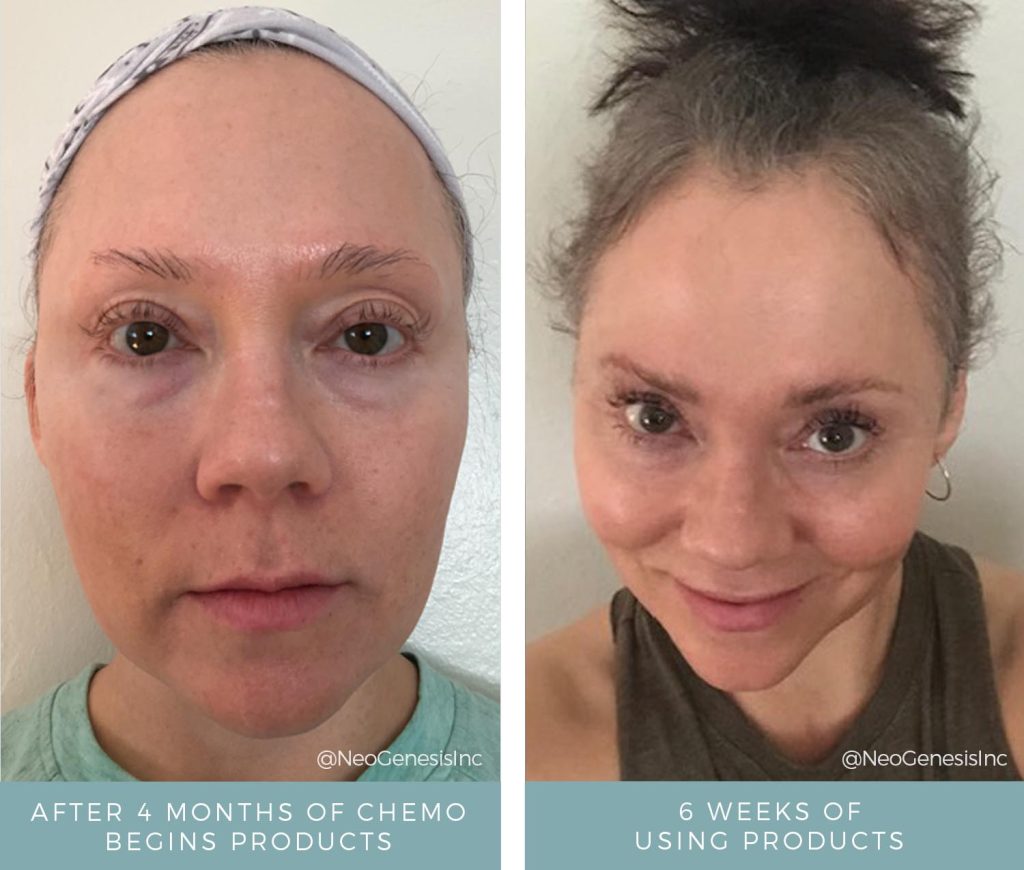Chemotherapy

“After experiencing severe scarring and painful side effects while undergoing chemotherapy treatment using Fluorouracil (5FU), this client started to use NeoGenesis products before her next round of chemo on her chest area. She was very excited to try the products on her chest to see if they would provide some relief to her skin issues during the treatments. Her skin was crawling with the 5FU on her face.
The NeoGenesis products really made her skin feel better and she was amazed at the results. The skin healed so quickly. The difference between the chemo side effects on her face and her chest is incredible. She was not feeling any pain at all on her chest.” – Tammy N.
Note: The redness on her chest is just her skin hue.
PRODUCTS USED:
Cleanser, Recovery, Barrier Renewal Cream, Moisturizing Mist
PROTOCOL:
Cleanser, Moisturizing Mist, Recovery, Eye Serum, Barrier Renewal Cream – 2x Daily
Moisturizing Mist – as needed throughout the day
FEATURED VIDEOS
CHEMOTHERAPY SIDE EFFECTS
Side effects are common among patients undergoing Fluorouracil chemotherapy, a type of cancer treatment. These side effects can range from mild to severe and may affect different parts of the body, including the skin.
Fluorouracil is a medication that works by interfering with the growth and reproduction of cancer cells in the body. However, it also affects normal cells, leading to various side effects. When it comes to the skin, Fluorouracil chemotherapy can cause a range of reactions and changes.
One of the most common side effects of Fluorouracil on the skin is dryness and irritation. This is because the medication causes a decrease in oil production, resulting in a lack of moisture on the skin’s surface. Patients may experience dry, itchy, and flaky skin as a result. In some cases, this can lead to cracking and bleeding of the skin.
In addition to dryness, Fluorouracil chemotherapy can also cause changes in skin pigmentation. This is due to the medication’s effect on melanin production. Some patients may experience darkening or lightening of their skin, particularly in areas that are exposed to the sun. This can lead to uneven skin tone and dark spots on the face, hands, or other parts of the body.
Another side effect to the skin is photosensitivity, which is an increased sensitivity to sunlight. Patients undergoing Fluorouracil chemotherapy may experience severe sunburns even with minimal exposure to UV rays.
In rare cases, Fluorouracil chemotherapy may also cause more severe skin reactions such as blistering, peeling, and ulceration. These side effects are known as hand-foot syndrome and can be very painful. It typically occurs on the palms of the hands and soles of the feet, making it difficult for patients to walk or use their hands.
To manage these side effects, patients are advised to take extra care of their skin while undergoing Fluorouracil chemotherapy. This includes using gentle skincare products, avoiding direct sunlight, and wearing protective clothing when going outside. By being aware of these potential side effects, patients can better prepare and take necessary precautions to minimize their impact on their skin during this challenging time.

“After experiencing severe scarring and painful side effects while undergoing chemotherapy treatment using Fluorouracil (5FU), this client started to use NeoGenesis products before her next round of chemo on her chest area. She was very excited to try the products on her chest to see if they would provide some relief to her skin issues during the treatments. Her skin was crawling with the 5FU on her face.
The NeoGenesis products really made her skin feel better and she was amazed at the results. The skin healed so quickly. The difference between the chemo side effects on her face and her chest is incredible. She was not feeling any pain at all on her chest.” – Tammy N.
Note: The redness on her chest is just her skin hue.
PRODUCTS USED:
Cleanser, Recovery, Barrier Renewal Cream, Moisturizing Mist
PROTOCOL:
Cleanser, Moisturizing Mist, Recovery, Eye Serum, Barrier Renewal Cream – 2x Daily
Moisturizing Mist – as needed throughout the day
FEATURED VIDEOS
CHEMOTHERAPY SIDE EFFECTS
Side effects are common among patients undergoing Fluorouracil chemotherapy, a type of cancer treatment. These side effects can range from mild to severe and may affect different parts of the body, including the skin.
Fluorouracil is a medication that works by interfering with the growth and reproduction of cancer cells in the body. However, it also affects normal cells, leading to various side effects. When it comes to the skin, Fluorouracil chemotherapy can cause a range of reactions and changes.
One of the most common side effects of Fluorouracil on the skin is dryness and irritation. This is because the medication causes a decrease in oil production, resulting in a lack of moisture on the skin’s surface. Patients may experience dry, itchy, and flaky skin as a result. In some cases, this can lead to cracking and bleeding of the skin.
In addition to dryness, Fluorouracil chemotherapy can also cause changes in skin pigmentation. This is due to the medication’s effect on melanin production. Some patients may experience darkening or lightening of their skin, particularly in areas that are exposed to the sun. This can lead to uneven skin tone and dark spots on the face, hands, or other parts of the body.
Another side effect to the skin is photosensitivity, which is an increased sensitivity to sunlight. Patients undergoing Fluorouracil chemotherapy may experience severe sunburns even with minimal exposure to UV rays.
In rare cases, Fluorouracil chemotherapy may also cause more severe skin reactions such as blistering, peeling, and ulceration. These side effects are known as hand-foot syndrome and can be very painful. It typically occurs on the palms of the hands and soles of the feet, making it difficult for patients to walk or use their hands.
To manage these side effects, patients are advised to take extra care of their skin while undergoing Fluorouracil chemotherapy. This includes using gentle skincare products, avoiding direct sunlight, and wearing protective clothing when going outside. By being aware of these potential side effects, patients can better prepare and take necessary precautions to minimize their impact on their skin during this challenging time.





